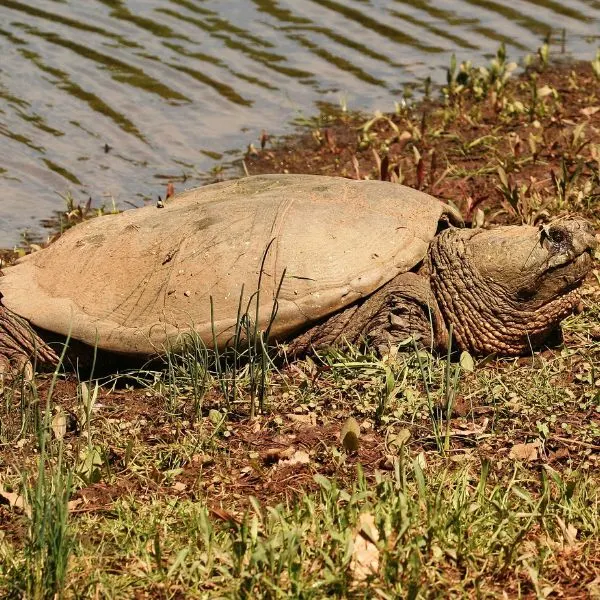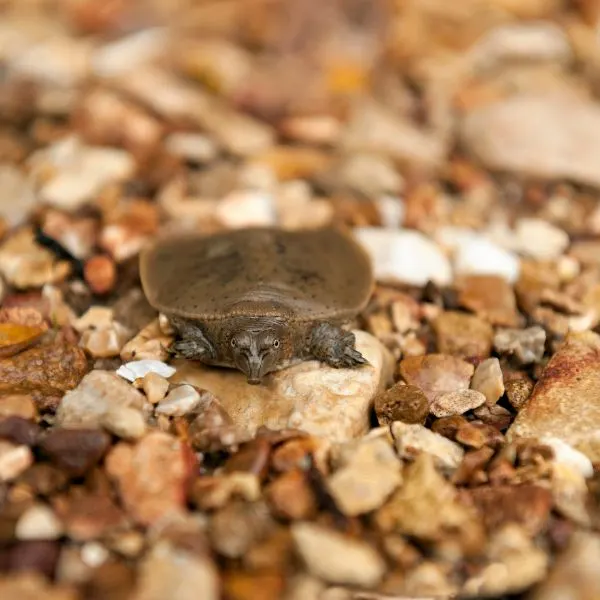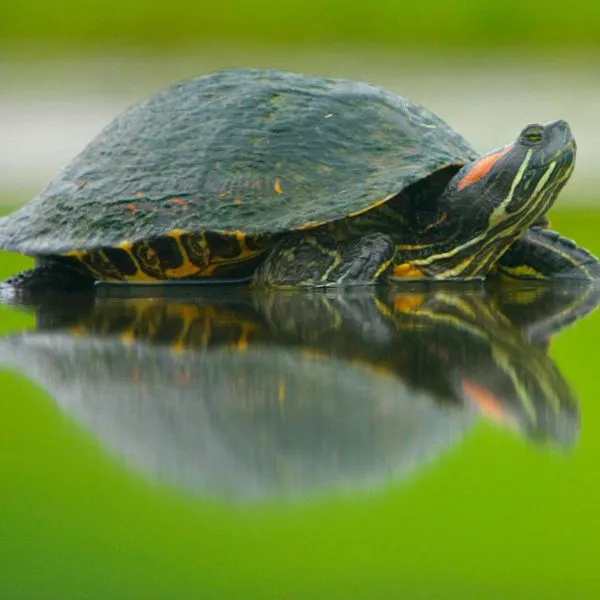There are six species of turtles in Wyoming. Four of them are Wyoming natives, while two have been introduced and are considered invasive. Most of them are usually found in ponds, streams, and lakes, but the Ornate Box Turtle is a more terrestrial dweller.
The two non-native turtles found in Wyoming are the Red-Eared Slider, and the very large, Alligator Snapping Turtle. These two turtles have recently made Wyoming waterways their home and are now competing with native species for resources. They were probably erroneously introduced into the wild, with the best of intentions.
Here we’ll go into detail about these six types of turtles; such as where they can be found, what they eat, and how to identify them.
Table of Contents
Native Turtles In Wyoming
1) Ornate Box Turtle

- Experience Level: Intermediate to Expert
- Family: Emydidae
- Scientific Name: Terrapine Ornata
- Other Names: Plains Box turtle, Western Box turtle
- Adult Size: Between 4 and 6 inches, shell length
- Lifespan: Up to 60 years in captivity, and average 25 years in the wild
- Average Price Range: Between $200 and $350
The Ornate Box turtle is a small terrestrial turtle that has a high domed upper shell, with a hinged lower shell. The hinge on the lower part of the shell allows the turtle to completely enclose itself into its shell for protection.
The main coloration is usually brown to black with bright, interesting lines and stripes that are yellowish or orange. Their skin and scales are green to black with bright colored spots on the scales. Females have yellowish brown eyes, while the smaller males have red irises.
Ornate box turtles call the grasslands and prairies their home in Wyoming. Their range extends along the Nebraska and Colorado borders.
Their diet consists of basically anything they can find. They will eat insects, such as grasshoppers, beetles, and caterpillars, as well as worms and mollusks such as snails. Ornate box turtles will also eat fruits and greens as well.
When it’s available, the Ornate Box Turtle will eat carrion and meat as well. They rarely pass up an opportunity for a meal if they are hungry.
Ornate Box Turtles Are Threatened
The Ornate Box Turtle has been listed as threatened in most of the states it calls home. This decline in population is due largely to habitat destruction, roads, and people trying to keep wild ornate box turtles as pets.
Captive bred Ornate Box Turtles are a better option if you are wanting one as a pet. When they are taken from the wild, the turtle usually stresses out so much that they starve, or succumb to illness.
Roads are very detrimental to this species of turtle as well. They are small, and move slowly across the road. When cars approach, their instinct is to hide in their shells, which are no match for car tires.
A word of advice for when you find a turtle on the road. If you want to help it cross, that’s fine, just be safe doing so, and always put the turtle on the side of the road they were facing. If they are heading to the left, put them on the left side of the road.
When turtles are moved in the opposite direction they were headed, they will just turn around and go back, leaving them vulnerable again.
2) Western Painted Turtle

- Experience Level: Beginner
- Family: Emydidae
- Scientific Name: Chrysemys Picta Belli
- Other Names: N/A
- Adult Size: Between 4 and 10 inches
- Lifespan: Between 30 and 50 years
- Average Price Range: Between $30 and $150
Western Painted Turtles live on the eastern side of the state, in shallow, freshwater areas that have muddy bottoms and typically a lot of vegetation. Often they can be found crowded on top of logs and sandbars where they like to bask in the warm sun.
The shells of these turtles are slightly curved, flatter, olive green shells that often have brighter colors along the edges. These colors can be yellow, orange, or red, similar to the stripes on their faces.
These aquatic turtles are omnivores, meaning they will eat meat, insects, and plants including algae. Some of their favorite foods include mollusks, fish, insects, and amphibians.
Like the ornate box turtle, Western Painted Turtles are not opposed to eating carrion when it’s available. They will also feed on vegetation in the water. They need to be submerged in the water to be able to swallow their food.
Not Listed As Threatened, But Still Susceptible
While these turtles aren’t considered threatened or endangered, they are particularly susceptible to industrial pesticide runoff, cars and predation. They have many predators—especially when they are young hatchlings—such as raccoons, ravens, rodents, snakes and skunks.
Roads are hazardous to these turtles as well. Females will often meet their doom when they have to cross roadways in order to lay their eggs.
3) Common Snapping Turtle

- Experience Level: Intermediate to Expert
- Family: Chelydridae
- Scientific Name: Chelydra Serpentina
- Other Names: Common Snapper, Eastern Snapping turtle, Snapper
- Adult Size: Between 8 and 20 inches
- Lifespan: Between 30 and 50 years
- Average Price Range: Between $40 and $120
The Common Snapping Turtle can be found in most bodies of water throughout Wyoming, some have even been found in brackish waters. They prefer slow-moving habitats with muddy bottoms where they can hide. Ponds, lakes, and muddy wetlands are some of the snapping turtle’s favorite bodies of water.
They spend so much time on the bottom of their habitat that their shells are often covered in algae or moss.
Common Snapping Turtles have distinctive features. They have large, thick shells with angular, jagged back edges that resemble saw teeth. On the top of their shells they have three keels (ridge, or raised line) running from front to back.
Their big shells offer little protection as their limbs, tail and head can’t retract into the shell much. Instead they rely on an aggressive attitude to protect themselves when they are out of the water. Some may even release a foul-smelling musk to frighten possible predators away.
When snapping turtles are within the safety of the water, they tend to hide in the mud or swim away to avoid trouble.
Snapping turtles have large heads, long necks, sharp beaks, beefy limbs, and long tails. When threatened they will open their mouths wide and hiss. When something gets too close, their heads will strike out like a snake and they will bite with a force strong enough to break bones.
The Common Snapping Turtle is usually dark colored. Their skin and carapace range from dark green to brown and black.
These big turtles are omnivores, but tend to prefer meat, only about a third of their diet consists of plant matter. They will eat fish, insects, worms, frogs, other turtles, snakes, crayfish, and small waterfowl if they get too close.
It’s not uncommon for snapping turtles to snap ducklings out of the water.
Common Snapping Turtle Numbers Are Doing Well
The Common Snapping Turtle is not listed as threatened or endangered. Their numbers are still doing well because they don’t have many natural predators. Unfortunately many succumb to busy roadways and cars.
During the rainy periods in the spring and summer months, snapping turtles can travel between bodies of water. It’s during these migrations that many get run over.
I once came across a small snapping turtle with a broken shell, while hiking in North Carolina. I tried to rescue it, but it didn’t make it. Be careful when traveling on the roads and keep your eyes peeled for turtles trying to cross.
4) Spiny Softshell Turtle

- Experience Level: Intermediate to Expert
- Family: Trionychidae
- Scientific Name: Apalone Spinifera Spinifera
- Other Names: N/A
- Adult Size: 5 to 9 ½ inches for males, 9 to 20 inches for females
- Lifespan: Between 40 and 60 years
- Average Price Range: Between $50 and $280
The Spiny Softshell Turtle is one of the largest aquatic turtles in North America. They are eclipsed only by the Alligator Snapping Turtle. They are called spiny softshell turtles because of the bumpy nodules along the front ridge of their rubbery shell.
These turtles have a flattened appearance and often look like “leathery pancakes.” Their carapace and skin are usually tan to olive colored with black spots or blotches along the top of the shell and body.
Another distinguishing characteristic for these turtles is the long snout protruding off their face. Most times all anyone sees of the turtles are the small eyes and snout sticking out of the water as they take in air.
They are found in the Bighorn River area of Wyoming, but many local residents have been reporting fewer numbers of these turtles. They have not been listed as threatened or endangered in the United states, but they have received protective status in Canada.
Trying To Get The Spiny Softshell Turtle Listed As Threatened
There are actions being taken to have the Spiny Softshell Turtle listed as threatened by the National Wildlife Federation. Especially since it appears that numbers are steadily in decline in Wyoming and other states.
The Spiny Softshell Turtle prefers water habitats with sandy bottoms or shores where they can hide and lay their eggs on the soft banks.
These turtles are mostly carnivorous, but will occasionally eat plants. In captivity they need to be fed a diet consisting of both meat and vegetation. In the wild, these turtles will eat anything they can swallow whole.
Fish, crayfish, mollusks, insects, and worms make up the majority of their diet in the wild.
An interesting fact about softshell turtles is they can stay submerged in the water for months at a time. They are able to obtain oxygen through their skin, cloaca, and pharyngeal lining.
These turtles are very skittish and will swim quickly away whenever someone gets close to them, but if they are caught outside of the water, they can be aggressive and bite. They have long necks that can reach nearly halfway around their shells.
Non-native Turtles In Wyoming
Non-native species of plants, animals, and insects can cause extensive damage to the ecosystem. Sometimes they can breed prolifically because there are no natural predators to keep numbers in check. And other times these animals often compete for food, habitat, and other resources that may put native numbers in peril.
Most times invasive animals get introduced into the wild when pets or captive specimens are released into the wild, or they accidentally escape. Oftentimes people do this with pets they can no longer take care of. Unfortunately turtles and tortoises are victims of this because they can have such long lifespans.
Some tortoises can live for over 100 years, which means they outlive their caretakers. When this happens, many family members don’t know how to, or are unwilling to take care of these pets. Many of us already have too many responsibilities already.
Mistakenly, people let the pets run off in the wild, thinking they are saving the animal from a cruel fate, but this can be detrimental to the pet, and the environment. Most times pets die because they don’t know how to fend for themselves in the wild.
While there are other times when these pets end up becoming a nuisance to native species. The Red-eared Slider and Alligator Snapping Turtle are two instances of non-native turtles that have become nuisances in Wyoming.
5) Red-eared Slider

- Experience Level: Beginner
- Family: Emydidae
- Scientific Name: Trachemys Scripta Elegans
- Other Names: Water Slider turtle, Red-eared Terrapin
- Adult Size: Between 6 and 8 inches
- Lifespan: Between 20 and 40 years
- Average Price Range: Between $30 and $100
Red-Eared Sliders are one of the most popular turtles people own as pets. They are easy to care for and have mild temperaments. They live for a long time, but not for decades like some land tortoises.
Another trait that makes Red-Eared Sliders so popular is because they are very active pets. You will often see them swimming animatedly through their enclosure, or basking under their heat lamp.
Red-Eared Sliders are pretty intelligent, and they will end up recognizing their owners and come when they see them.
These turtles sport dark green shells with lighter undersides. They have light yellow markings on their scutes, and stripes running along their heads and necks. They get their name from the bright red markings on either side of their heads, that look like ears.
They like the same habitats as most of Wyoming’s native turtles. Slow-moving waters in ponds, lakes, and wetlands offer plenty of opportunity for Red-Eared Sliders.
What Makes The Red-Eared Slider Invasive?
These aquatic turtles are omnivores that feed on small fish, invertebrates, insects, amphibians, and vegetation. They often eat the same food that other native species will eat meaning there is less food for native turtles. This can cause smaller populations native turtles.
Red-Eared Sliders also don’t have many natural predators in Wyoming. Mostly, alligators and crocodiles feed on the adults because their shells protect them from other possible predators.
The fact that they rarely leave the water means that larger mammals don’t feed on Red-Eared Sliders. With few predators, these turtles can breed rapidly and outcompete native species.
Red-Eared Sliders may also carry illnesses and diseases that native species of turtles aren’t immune to. Meaning sickness can spread quickly through native turtle species.
6) Alligator Snapping Turtle

- Experience Level: Intermediate to Expert
- Family: Chelydridae
- Scientific Name: Macroclemys Temminckii
- Other Names: Loggerhead Snapper, Alligator Snapper
- Adult Size: Between 15 and 29 inches
- Lifespan: Between 60 and 70 years
Alligator Snapping Turtles are the largest freshwater turtle species in North America. They can grow up to 30” long from front to back of the shell and weigh in excess of 250 pounds.
You have probably seen them on TV shows when people pick them up out of slow-moving waters. They come up with their mouths agape, looking quite menacing.
They have heavily ridged shells with jagged edges, and pointy scutes. They have thick muscular limbs, long and meaty tails, and large frightening looking heads.
Alligator Snapping Turtles originate from the southern United States and range along the Gulf Coast through Florida, Georgia, Louisiana, and Texas. Their natural habitat ranged as far north as Illinois and Iowa, but have recently been found in Wyoming.
Though these giants look like something from Jurassic Park, they aren’t very aggressive unless they are frightened and provoked. They don’t attack people in the water and underwater attacks are exceptionally rare.
On land though, the Alligator Snapping Turtle can defend itself with a bite force of nearly 1000 pounds. If you see one out of the water, the best thing to do is leave it alone, or call animal control services.
The Alligator Snapping Turtle will eat nearly anything it can get into its mouth. This includes fish, amphibians, insects, snakes, turtles, small mammals, and the occasional piece of plant matter.
They have a small wormlike protrusion on their tongue which they will wiggle to attract fish. This turtle likes to lay in wait at the bottom of a lake or pond with their mouth open wiggling the protrusion, and when something gets too close, they will snap down and swallow it.
Why Alligator Snapping Turtles Are Invasive
There are no animals that will tangle with an alligator snapping turtle in Wyoming, so they can breed unchecked. While they are small they may get preyed upon by other large turtles, raccoons, and snakes, but once they get a few inches long, they don’t have much to fear aside from humans.
Since they eat so many different species of animals, they don’t have a problem getting food. This takes away food from native species which strains their numbers.
Wrapping It Up
Now you know the four native species of Wyoming turtles, and two species of non-native, invasive turtles. If you happen to see alligator snapping turtles, or red-eared sliders in Wyoming’s local waterways, contact your local animal control offices. They may be trying to control populations.
And if you or anyone you know have pets that are no longer able to be cared for, reach out to local reptile breeders or adoption agencies. They can help to find people who can and are willing to take in these animals.
We hope you enjoyed this article. If you did, leave us a comment below and tell us about your turtles or experiences with this amazing reptile.
Other nearby states
